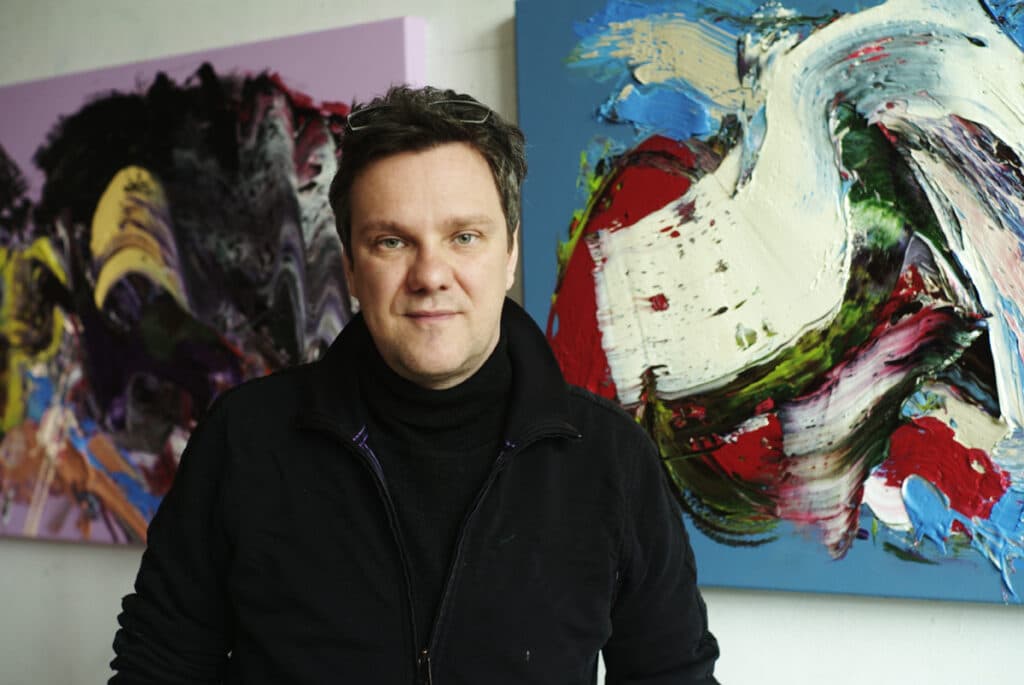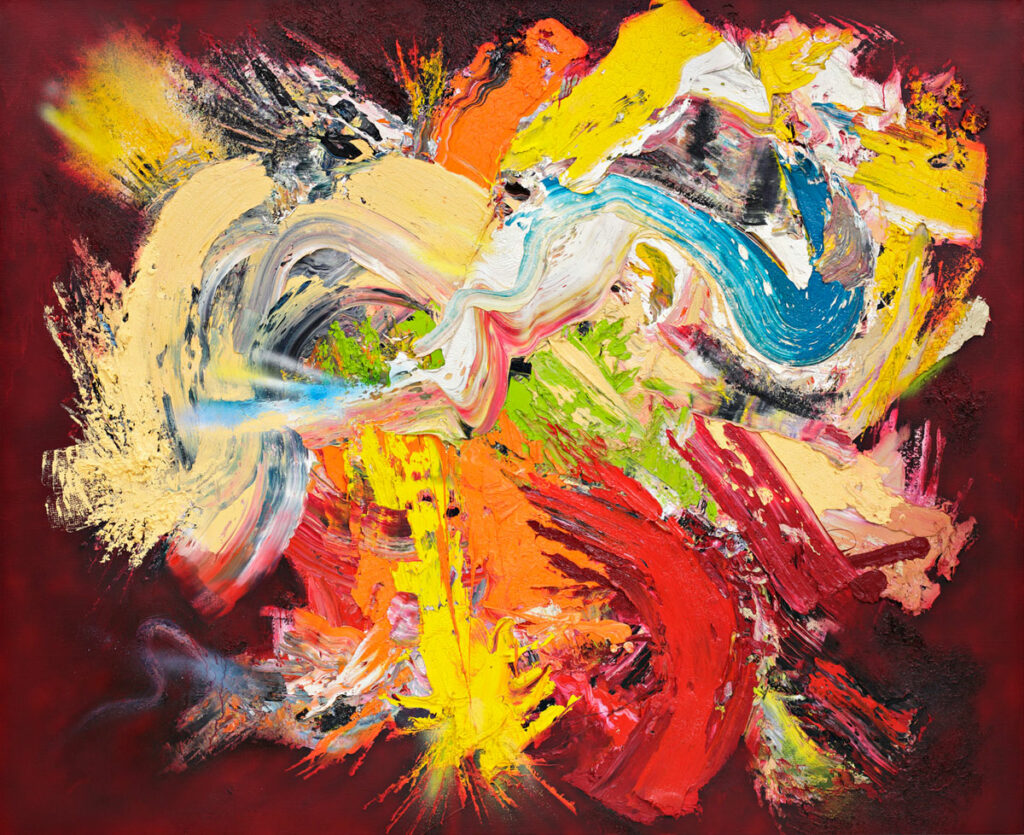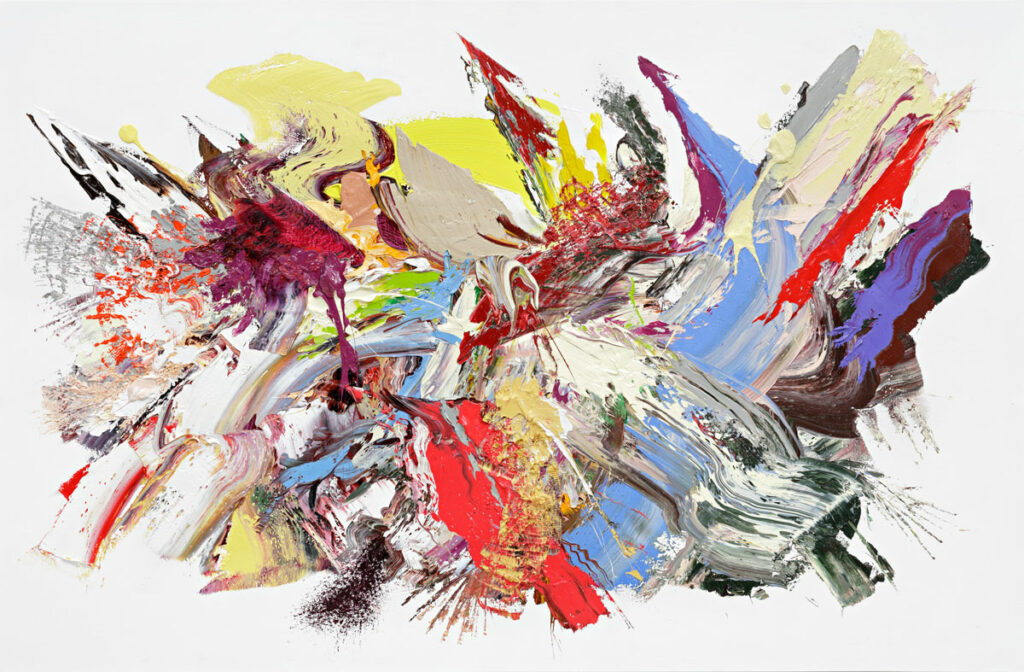Born in Berlin, Sebastian Heiner studied at the UdK (Universität der Künste) in his home town. Normally he works and lives in Berlin, where he shares an atelier with the artist Jörn Grothkopp. The Berliner told us as well, that his painting is influenced a lot by his temporary employment abroad. Over several years he held ateliers in Beijing, Shanghai and Bangkok. “I think, a lot broke loose inside of me while I was staying abroad. Before, I had the feeling that my painting got stuck in some kind of way. But the shock of the metropolis, the shock of the alien, highly opened myself up. I could return to colours, began to scratch inside of it and tried to find traces. (…) But also to be exposed to a completely different cultural context, I sensed as very fundamental and worth discovering for me. In a manner of speaking, I could find myself inside of the exceptional circumstances: inside of the foreign parts, far away from my cultural identity. I was able to return to myself – and was struck by this contradiction: To leave, to come back.” His devotion and examination of the Asian culture is significant and can be seen in his work. His paintings stand-out because of their abstract colouring and their graphic representation.

#1 The perception of the artist
“With both of us artists it’s mainly about perception. We talk a lot about what reality really is. We observe the world differently and try to identify how the other one sees it, how we differ from one another and where we meet again. For sure we meet within the steady challenge of our own position. For both it’s about the process of creating. The process, for us, is much more important than the outcome, the journey is the reward. It’s about the various options of the appearance of a painting, given that it’s beautiful, how diverse our variations are. We love the exchange, also with other people, and I consider it to be crucially important. It helps staying loose, to not freeze yourself and to keep the doors open.”
#2 The stage of the artist
“My domain of painting I seize as a stage. If I change, I try to cut myself out and to focus on my work. I leave the routine and pass the border into chaos, where I don’t possess anything but myself. The clothes are the skin, the stage is the screen. Then it’s about the design: I work quite physically. Sometimes I squeeze out the tubes on the floor, so that I first offer a ground of colours. Other Times I reach in with my hand to then directly smudge the colours with my body on the canvas. Or I take cardboard, dip it in colour and pull it over the linen. It has to be fast, direct and spontaneous. In that context I’m thinking about the work with China ink in Asia and that you have to concentrate to pick the right moment to do the right thing. This moment is the accuracy inside of the chaos. One has to follow his intuition. It may also happen that I created a composition I really like – besides a tiny moment, that brings down the whole system. It’s a series of reactions. The picture, that seems to appear randomly, eventually is always considered a system of elements. These elements have to experience some kind of order. The exemption might be illusory, because you always have certain modules and pieces available. Me, I have a particular movement I perform over and over again with my arm, without noticing. A specific repertoire is in some ways restrictive, too. Of course I can create lots of variations out of my repertoire, but still my great fear is the development of automatisms and a routine. In contrast I have to fight against it repeatedly, that’s why I change the main colour or the size and have to step back. Everyone has their own style: even the physical and psychic structure defines the elements one is provided with. It’s not about changing the repertoire of elements, at the most to widen it to its maximum. The dangers for creativity are the routine and the uniformity.”

#3 The working process of the artist
“It gets interesting when there is no concrete idea. It challenges me to always start at zero. That means not to have any deadlocked idea, or to have a ready-made opinion, but to act out of the moment and coincidence to then see that there will always arise a similar line. That way one cannot even act different than on his own terms. One leaves quite a lot behind, until he can only be what he is. My motivation exists out of the goal to not let anyone press me into one scheme, that’s why I even change the size of my canvas. So I also question myself technically. It’s a recurring question, which results out of a certain insecurity. I have to try something new again to challenge myself.”
“If mistakes occur, the worst case scenario is that I have to start a new painting. It might even be sorted out or I paint over it, which should only happen to a certain extent, because the freshness and immediacy otherwise get lost. Sometimes I mistrust the fast outcome, you always have to be on the watch, to always question yourself critically and to always be concentrated while doing so. I’m a huge fan of pragmatism. Maybe it’s because of the fear of chaos and the loss of control. It’s about keeping a balance between the disorder and a sorted, practically oriented world and tolerating this tension. The live is a subject to a messy principle, but there has to be some kind of order, otherwise the chaos would be destructive. It’s a dialectic assumption of the world out of two opposites, to create something and to question the creation afterwards again.”
#4 The rules of the artist
“It’s important to go step by step and to make decisions. To limit the dynamic of the chaos, you have to try to contain the things rationally, until you get to a result. I try to grasp the dynamic of the chaos within a small moment, like in chess. The chessboard is liable to the chaos and you try to rule over it. Therefore you need courage, because maybe you can’t control the entities even if you try. The risk of failing always exists. Yet it can be a struggle for existence, because you are a freelancer and you have to make your own rules day-in, day-out, even if you can’t enforce anything. You have to cultivate and renew your network and contacts all the time. It’s a current tension, because you are pressured forever with improvisation. Every day is new. There is never a guarantee for anything, but all of that can be very attractive as well. The resonance and the acknowledgement are essential. Within pure isolation you cannot create anything and that’s why you have to maintain the exchange. Otherwise the man folds.”

#5 What business can learn from artists
“From the process of the permanent self-renewal and the not standing still. That you keep having the courage to search for solutions and solve problems and to stay agile and open minded along the way. That they realise, that there is no security, only consistently new moments. That you do teamwork and communicate with your partner, so that you don’t achieve the things for yourself but together. That they believe in themselves and in one another. The belief in yourself is the strongest impulse to be able to find solutions. There is always an answer, even if it’s different from what you expected. Sometimes the answer doesn’t have a solution. I think, everyone can experience more: No matter if president, cashier, or professor. It’s about everyone displaying the things within his own possibilities and abilities and therefore brings out the best in himself. Meanwhile you should stay human and believe in the inventive quality even if there is not much tolerance. It’s about cultivating the positive, human skills: compassion, sympathy, exchange, help, etc., everyone can achieve that. Basically the economy wants to develop and to push something, those are basic elements of human action. You want to earn something and to create an additional benefit, that’s why there has to be a strategy to imply the creative. Without vision you cannot develop any strategy or product. The art is just a symbol for intense, human action. If you want to achieve something, you have to be brave, willing to take risks, curious and have fun. It doesn’t work if you are stubborn and without a certain freedom. There has to be conditions for the creative as well.” Additionally, Sebastian Heiner answered the question if he’s more resistant because of his art: “I think so. But that slowly developed over the years.”
The complete interview with Sebastian Heiner in German language
Info
Text by Dirk Dobiéy & Adina Asbeck.
The interview was conducted by Dirk Dobiéy on 12/03/2015.
Image source: Hans-Georg Gaul (for Sebastian Heiner) & Age of Artists.
